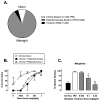Modulation of drug choice by extended drug access and withdrawal in rhesus monkeys: Implications for negative reinforcement as a driver of addiction and target for medications development
- PMID: 28442370
- PMCID: PMC5651207
- DOI: 10.1016/j.pbb.2017.04.006
Modulation of drug choice by extended drug access and withdrawal in rhesus monkeys: Implications for negative reinforcement as a driver of addiction and target for medications development
Abstract
Chronic drug exposure is hypothesized to recruit negative reinforcement processes that increase the magnitude and alter the mechanisms of drug reinforcement. Candidate substrates of negative reinforcement include increased signaling via stress-related neurotransmitters such as corticotropin releasing factor (CRF, acting at CRF receptors) or dynorphin (acting at kappa opioid receptors) and/or decreased signaling via reward-related neurotransmitters such as dopamine. Determinants of drug reinforcement can be examined with choice procedures, in which subjects choose between a drug of interest (e.g. heroin or cocaine) and a non-drug alternative reinforcer (e.g. food). This review summarizes evidence collected from studies of drug choice in rhesus monkeys to address the negative reinforcement hypothesis. In monkeys choosing between heroin and food, chronic heroin exposure and subsequent withdrawal produces a robust increase in heroin choice. This withdrawal-associated increase in heroin choice is blocked by morphine and by other mu opioid agonists used to treat opioid use disorder (methadone, buprenorphine); however, withdrawal-associated increases in heroin choice are not reliably blocked by antagonists of CRF or kappa opioid receptors or by an indirect dopamine agonist. In monkeys choosing between cocaine and food, chronic cocaine exposure and withdrawal fail to increase cocaine choice or alter sensitivity of cocaine choice to treatment with candidate therapeutics including an indirect dopamine agonist and a kappa opioid receptor antagonist. These results support a role for negative reinforcement in self-administration of heroin but not cocaine. The constellation of neurobiological changes that constitutes the negative reinforcing stimulus in opioid-dependent rhesus monkeys remains to be determined.
Copyright © 2017 Elsevier Inc. All rights reserved.
Figures


References
-
- Ator NA, Griffiths RR. Principles of drug abuse liability assessment in laboratory animals. Drug Alcohol Depend. 2003;70:S55–72. - PubMed
Publication types
MeSH terms
Substances
Grants and funding
LinkOut - more resources
Full Text Sources
Other Literature Sources
Medical
Research Materials

